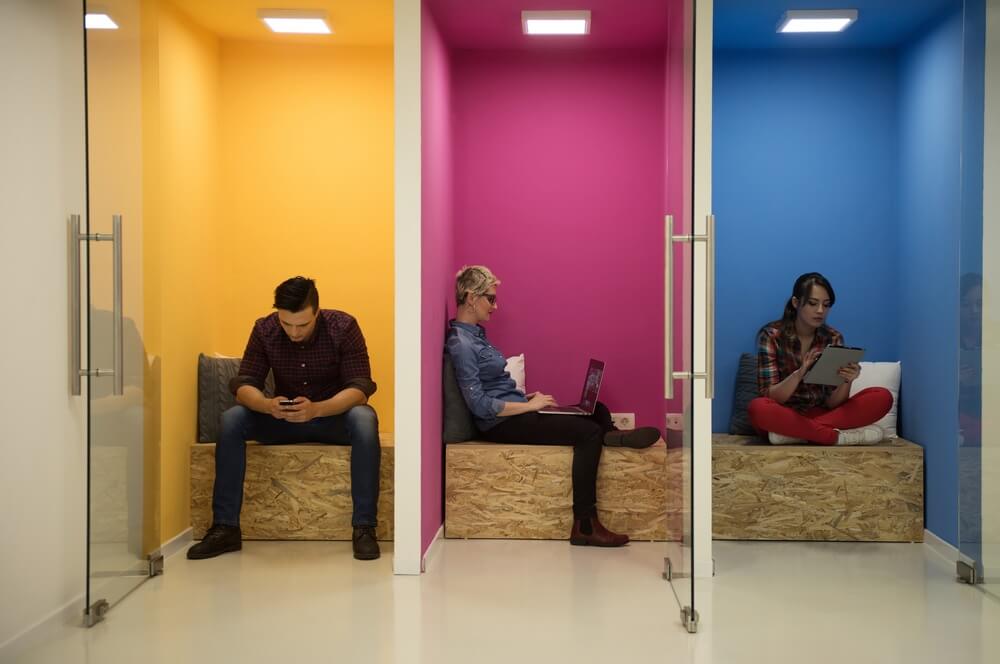Paul Haury, a corporate culture and leadership consultant, helps organizations by making people feel like they’re part of something bigger than themselves. We talk to Paul about how building meaningful connections can help productivity soar.
That was the motivation behind starting Heart Based Leading, which focuses in creating happy, healthy and fun workplaces to elevate team performance.
We started off by asking Paul to tell us a little more about his background and how he became interested in understanding and creating positive work cultures.
Paul: When I was in the fourth grade, I went to Camp Waskowitz — which is an outdoor life camp near Seattle. We had a troupe and there were two kids, my camp mates, in the bunkhouse and they were mortified that they weren’t hanging out with their parents at night. I walked over to one of them and said “hey, what’s the problem?” and suggested we should go play and build a fort. So, we took the bunks and stacked them so there was a fort we could all play in, but there was still one kid who was kind of shy in the group so I pulled him into play so that he’d be alright too.
My camp counsellor asked “why did you do that?” and I said “well, they weren’t having any fun, so I invited him over to have some fun.” He sat me down and told me “you should keep up that attitude because that’s going to help you someday in life.” I didn’t even think much about it, I was a kid at camp and just wanted to get back to goofing around, but that’s kind of been my mode in life: invite and have fun.
Fast forward from camp to twenty years ago, when teaching high school, I learned if I invited my students, with love and care for each one of them, they will learn because they want to, plain and simple. And, if they wanted it, then there was nothing that can get in their way. They will figure it out. All I had to do was provide a classroom fort with the right emotional and the right skills-developing environment to achieve our purpose. Our brains simply work better when we’re having fun.

We wondered how his experience teaching high school helped shape his approach to work cultures, and what kinds of parallels he found between the school system and workplace.
Paul: The parallels are pretty dramatic. People are people, whether in high school or adulthood. The key thing is we all function at the highest with people that we care about in life. It’s funny when we don’t even do the best for ourselves, but we will go to the ends of the Earth for somebody that we care about.
There’s an irony here. I gave every single one of my students my phone number and said “if you need me, call me.” Yet, in three years of teaching, I never had one student call me. The mere fact they knew my number meant I had their backs, when you get that kind of relational power — it’s phenomenal. They knew, and more importantly felt, that they mattered. It’s about heart!
The same thing if you’re a leader in a business, or even a teammate in a business. We always put the focus on leaders: “let’s develop leaders!” If you don’t have your people in that same focus where they are cared for and nurtured, to care for each other, then you have this well-trained leader and a bunch of people that don’t care.

What are the most important factors to keep in mind when trying to build an organization with a positive work culture that employees thrive in?
Paul: First and foremost, it has to be a priority, it has to be important. Sometimes an organization has an amazing culture by accident. Then you have places where it’s truly purposeful and that’s the key, to pay attention and hire for the right thing. It’s also not just about hiring for the right thing, it’s about nurturing, and you have to tend to it — it’s not something you can walk away from once you set it in motion. It will slowly die without care. A good culture only happens in a safe environment. It’s here where oxytocin and serotonin levels in our brains elevate so we can cooperate, challenge each other and work together as we relate.
Now take for example, telling someone to “knock that crap off.” You can only say “knock that crap off” to somebody if you have a really good relationship with them. If you say that to somebody without an established trust relationship, they’re likely to say“I guess I’m looking for a new job.” But if you say that to somebody you’ve invested time and heart in, and you’ve helped them grow and develop, they’ll care about the exasperation they might be giving you. Instead, they might say “I’m not letting you down, I’m going to get this.” That’s what you want from a cultural standpoint. I got your back! By the way, that doesn’t mean it’s going to be easy. It means don’t quit, I got you. That’s oxytocin.
For years I would differentiate between being nice and being kind at work, or in the classroom. People are always being nice so that they can avoid a problem or not hurt somebody’s feelings in the situation. The problem is, that can be really unkind. Not telling somebody that what they’re doing isn’t cutting it simply sets them up for continued failure. Radical kindness, now that’s caring enough about a person to deliver the uncomfortable message in order to help them to move to a higher level. Showing that you care while you’re being honest in a critical way with somebody is key. This is somewhat like Kim Scott’s book Radical Candor. But, if people and especially senior leadership, don’t buy into this, then it’s not going to work. The difference between criticism and guidance: the heart that it got delivered from. “I need better work from you” can mean I’m disappointed and you need to find a job or I’m counting on you, will you step up?

What are the biggest challenges you see in getting companies and organizations to change their approach to co-workers and employees.
Paul: I love that problem. Our brains follow the path of least resistance, so when we’re trying to break a habit, effectively, all we’re trying to do is rewrite a new path in our brain, so that when it comes to the point of making a choice, we can make a different choice. That’s really all it is. You may think you have a choice in a given situation, where you are considering the facts, but emotionally, those facts are simply what you feel comfortable with and where you got that knowledge from. It’s truly emotionally filtered all the way through. This is why it’s so tough, choice is an option of more than one path: neuropathway one, a stream, and neuropathway two, the Grand Canyon. Like water, it follows the easiest path. Huh? Our brain is mostly water.
Now consider when we have financial duress, it’s the same thing if we had a sabretooth tiger biting us on the back of our caveman and cavewoman necks. At that point, we lose the ability to be as empathetic as we could be. What we have in our financial system and our existing leaders are a bunch of people that all they’ve heard is money, money, money, numbers, numbers, numbers. Guess which neural pathways are burned in and the easiest to follow? Not the caring ones that result in amazing teamwork and resilience. To make things even more difficult, that duress can bring about chronic stress and a continual low-level response in your amygdala. Have you ever sat there feeling this angst in your gut or your chest. You feel uneasy. Your brain is responding as if you are under threat. In this state our bodies are releasing cortisol, something that’s very good when you need to get away from a sabertooth tiger. Not so good, when you’re trying to work with each other. Why? Because it’s reducing the oxytocin level that’s needed for cooperating with and caring for each other.
What that means is now you don’t take the extra effort as a good leader, a heart based leader. You go to your employee who’s having a problem, that hurt a delivery schedule, and you don’t say “hey, what’s happening? Normally you’d deliver this stuff on a dime, we’re actually late, what’s going on?” The heart based response of a leader would be “what can I do to get you in that space?” Instead, you throw a scowl or a punishing comment at them.
Changing this requires effort, mindfulness and time. If you put the effort and focus into creating better neuropathways, over time, change can occur. And, until that’s a priority on the level or above that of money, change is going to be really slow.
In terms of the physical environment, how can a facility manager affect workplace culture?
Paul: It really can’t be understated. There are two schools: there’s the cube group and the open office group. There are plus and minuses to both. From a cultural standpoint, it depends on what you want to create. If you want to create a bunch of individual focus spaces for people then that’s what you do. If you have a situation where you have to coordinate in a much more agile way, you’re going to have some crossing space and places for people to work.
The science behind this is pretty awesome. To give you an example, at my former company we had two floors and here’s how it would go: you’d be working and run into a situation where you have to go upstairs to ask a question, but instead, you decide “I’m going to finish this first because I don’t feel like walking upstairs.” This goes back to the path of least resistance. It’s easier to stay at your desk and just choose another task to work on than it is to stay on priority and go upstairs. If you had just walked upstairs and talked to the person, you’d have your answer, that priority of the project could move forward. Instead, you do something else because it’s just easier. It’s not that you’re saying “I’m going to do the easier thing” at the moment. It’s that our brains really like easier.
Take that same situation and put the company on one big floor. Whether you have cubes where you stand and look over to see if someone is there, or whether you just have dividers on desks in more of an open platform, now neurologically what goes on is “oh they’re right there” and that perception changes our ability to interpret the level of effort something is. Now, instead of that delay, the person gets up, walks over and talks. My former office went from the two-story to the one-story and that result was immediate.

To conclude, we asked Paul to give us his personal definition of “workplace happiness.”
Paul: It is completely individual and at the same time cultural. That’s where the science and the art of it has to come together. If you ask 24 people, you’ll have 24 different reasons why they’re happy at work. Sometimes people are happy because they love who they’re working with. Sometimes it’s the purpose and that purpose really matters. For some, they’re mercenaries. They just want to go in, make their buck, do some good then go play some more. As long as they get to do that, they will come in, be a contributor and bolt. It’s looking at happiness from the frame of people, purpose and pay. That’s how people are actually motivated in life.
Here’s an example of workplace happiness: people are moving fast, aligned and abuzz with positivity. You can see and feel that people are working together with drive and commitment to each other; with purpose, as they’re highly productive in getting things done. They challenge, and at the same time, support each other in efforts to be awesome. Then they celebrate their achievements together. You immediately want to be part of it. Cause it’s awesome.
To learn more about Heart Based Leading and how Paul is helping build workplace happiness, visit his website.
What are your thoughts on workplace happiness? Can it be achieved with the right leadership and employees? Join the conversation by telling us what you think in the comment section below.
Photos: Shutterstock, rawpixel.com, Shutterstock, Daria Nepriakhina





